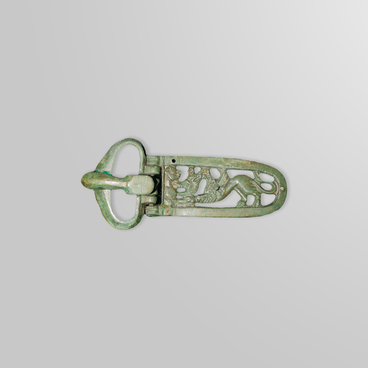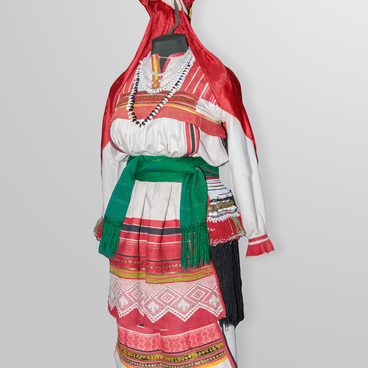The Staroe Badikovo burial grounds — archaeological monuments of the ancient Mordovians — were discovered near the village of Staroe Badikovo in Zubovo-Polyansky district of Mordovia. Staroe Badikovo burial ground II dates back to the 7th — early 9th century and is located to the north of the village, on the left bank of the Vad River. In 1975–1982, the archaeologists Viktor Shitov and Ivan Peterburgsky examined more than 300 burials of the burial ground. Their finds include tools, weapons, adornments, molded pottery vessels. Male warriors’ burials contained large silver clasps, female burials featured numerous temple pendants with a spiral and a bi-pyramidal weight. Archaeologists also found some imported items in the burials, including the displayed bronze clasp decorated with red enamel and a belt buckle with an image of a winged beast of prey.
Earrings, pulokeri hair decorations, syulgams, and beads — these were the finds that prompted archaeologists to determine the ancient Mordovian identity of the burial site. The most significant ethnic marker of the Mordovian archaeological monuments is a temple pendant in the form of a rod with a bi-pyramidal weight on the lower end and a horizontal spiral on the upper end. Such temple pendants with a weight were part of the female attire of the northern and southern Mordovian tribes. They were common elements of the ancient Mordovian costume for almost a thousand years.
During the long period of the 1st millennium the features of the material culture of the Mordovian tribes changed greatly. By the second half of this millennium more or less identical characteristics had developed in the Mordovian material culture. Certain features, typical of Moksha and Erzya people, can be traced at the end of this period. Archaeological materials confirm the idea that the division of the single Mordovian clan-tribal community into Moksha and Erzya ethnic groups began only in the middle of the 1st millennium A.D. The complete separation appears to have occurred at the beginning of the 2nd millennium.
Each epoch left the imprint of its aesthetic perceptions and technical mastery on the decorations, so the artifacts are valuable sources of information for studying the history of the Mordovian people. The museum collection includes materials from the burial grounds Zhuravkino II, Staroe Badikovo II and Shokshinsky.
Earrings, pulokeri hair decorations, syulgams, and beads — these were the finds that prompted archaeologists to determine the ancient Mordovian identity of the burial site. The most significant ethnic marker of the Mordovian archaeological monuments is a temple pendant in the form of a rod with a bi-pyramidal weight on the lower end and a horizontal spiral on the upper end. Such temple pendants with a weight were part of the female attire of the northern and southern Mordovian tribes. They were common elements of the ancient Mordovian costume for almost a thousand years.
During the long period of the 1st millennium the features of the material culture of the Mordovian tribes changed greatly. By the second half of this millennium more or less identical characteristics had developed in the Mordovian material culture. Certain features, typical of Moksha and Erzya people, can be traced at the end of this period. Archaeological materials confirm the idea that the division of the single Mordovian clan-tribal community into Moksha and Erzya ethnic groups began only in the middle of the 1st millennium A.D. The complete separation appears to have occurred at the beginning of the 2nd millennium.
Each epoch left the imprint of its aesthetic perceptions and technical mastery on the decorations, so the artifacts are valuable sources of information for studying the history of the Mordovian people. The museum collection includes materials from the burial grounds Zhuravkino II, Staroe Badikovo II and Shokshinsky.





